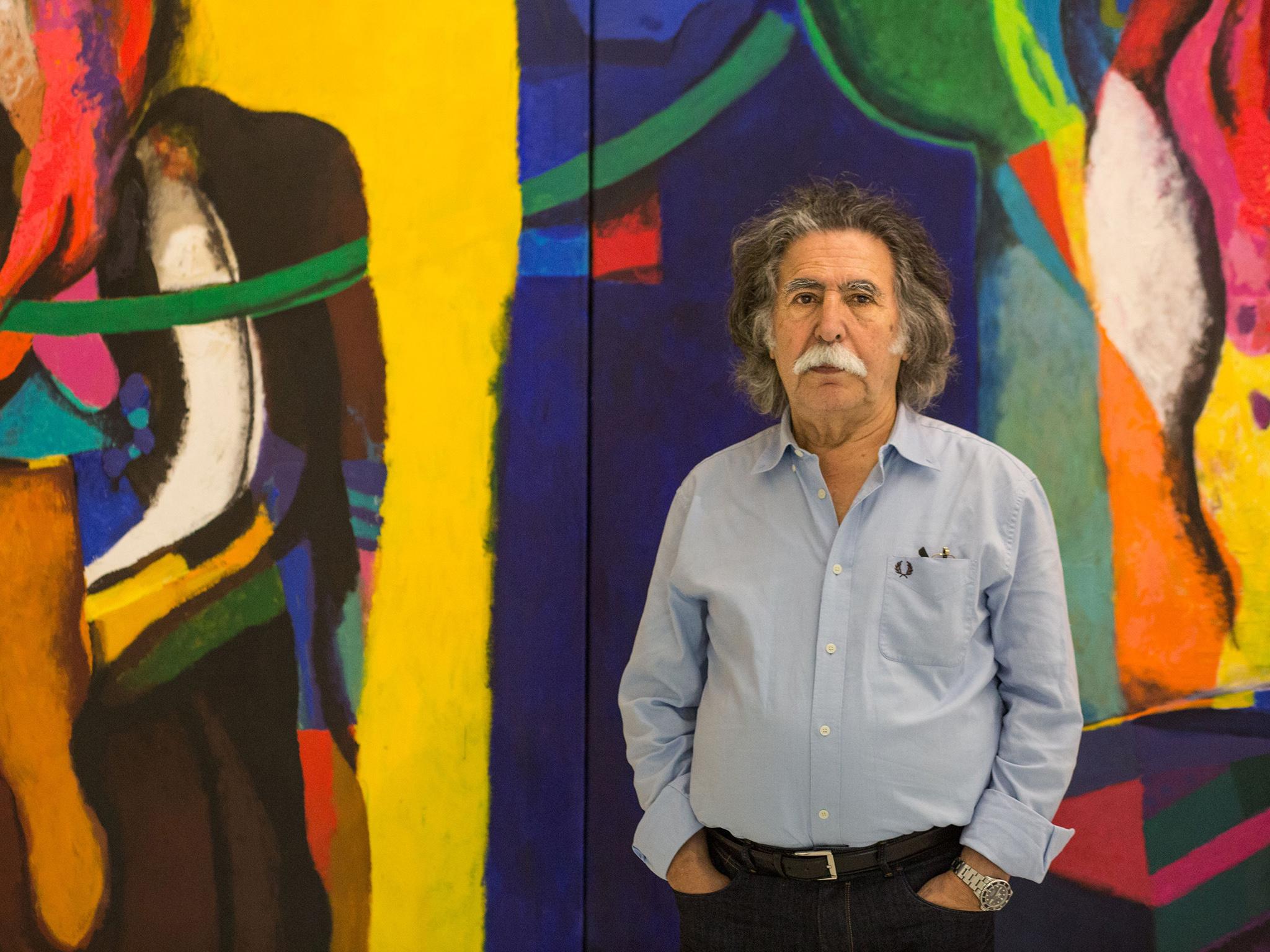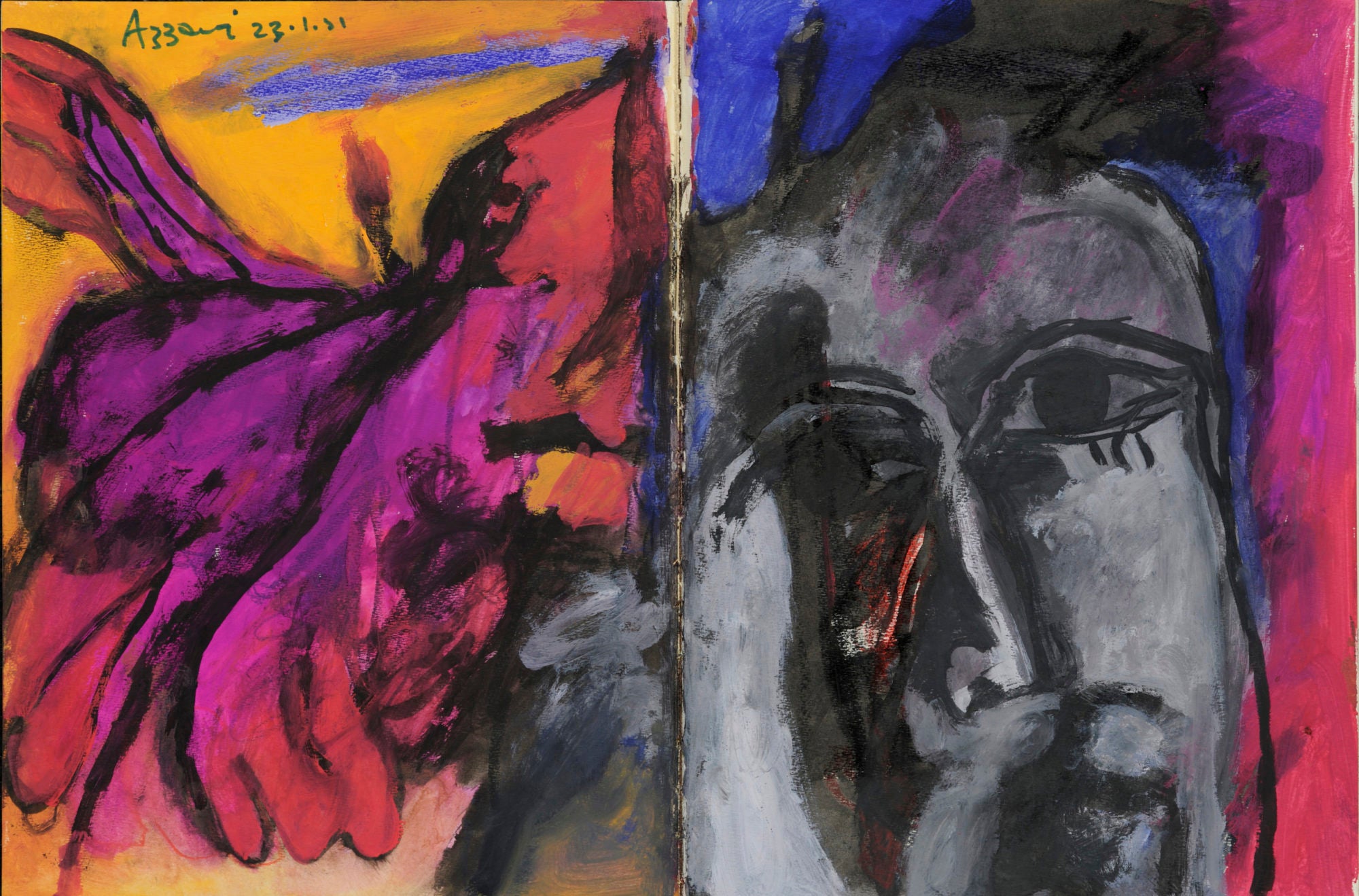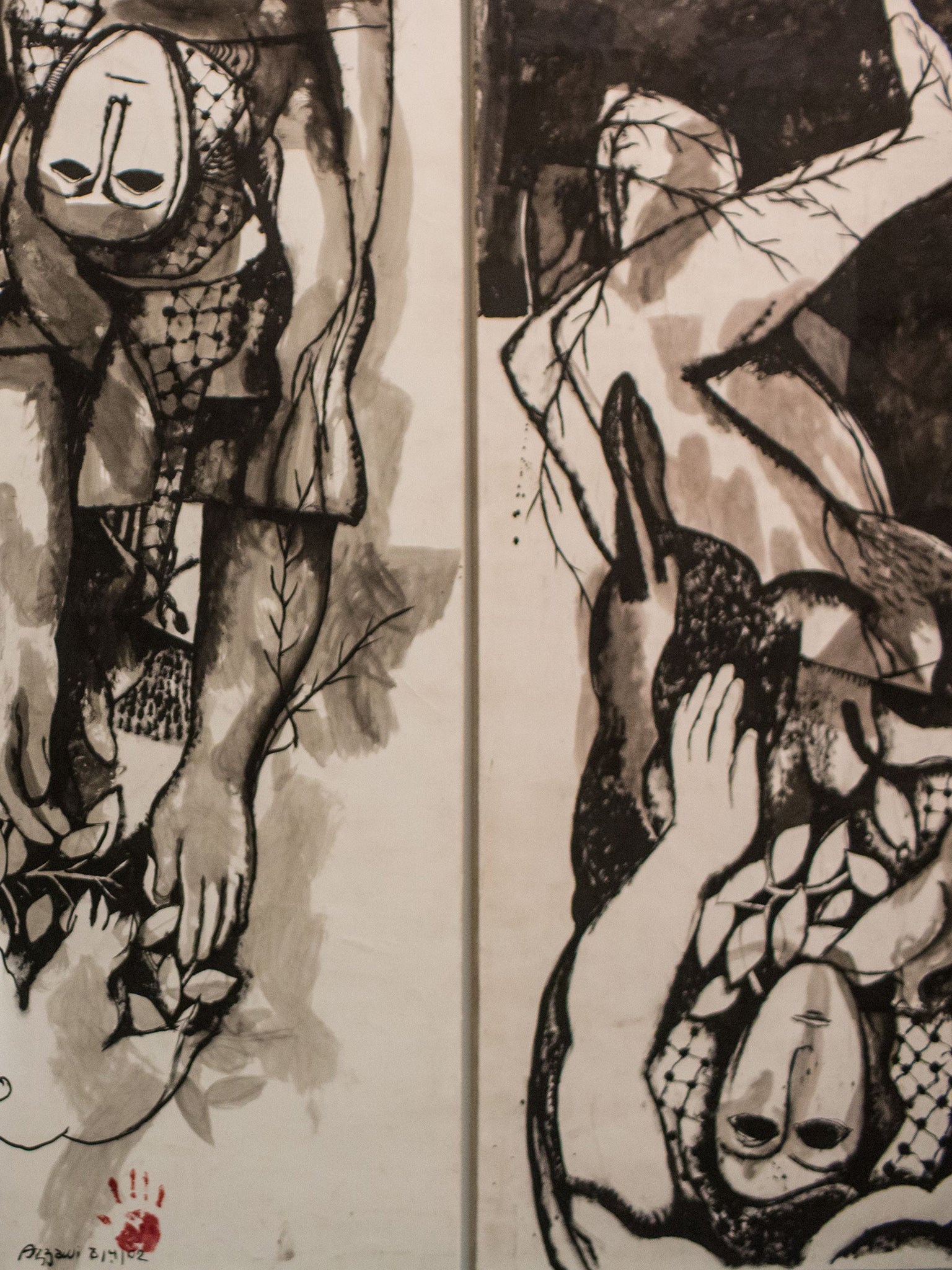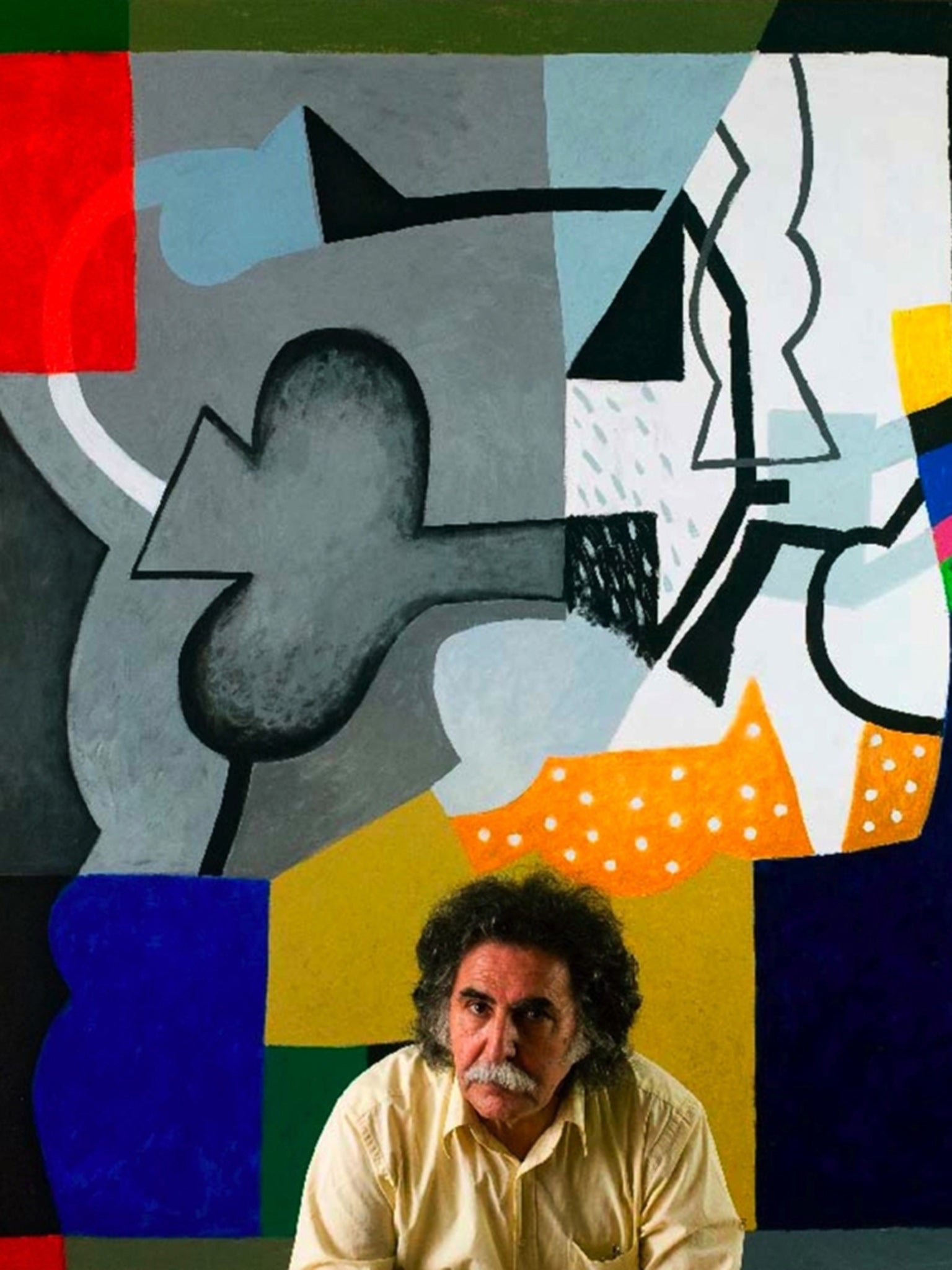How one Iraqi artist explores nationwide mourning through painting and sculpture
In both overt and abstract works, Dia al-Azzawi illustrates the consequences of war and the destruction his country has faced, writes Neil MacFarquhar

Your support helps us to tell the story
From reproductive rights to climate change to Big Tech, The Independent is on the ground when the story is developing. Whether it's investigating the financials of Elon Musk's pro-Trump PAC or producing our latest documentary, 'The A Word', which shines a light on the American women fighting for reproductive rights, we know how important it is to parse out the facts from the messaging.
At such a critical moment in US history, we need reporters on the ground. Your donation allows us to keep sending journalists to speak to both sides of the story.
The Independent is trusted by Americans across the entire political spectrum. And unlike many other quality news outlets, we choose not to lock Americans out of our reporting and analysis with paywalls. We believe quality journalism should be available to everyone, paid for by those who can afford it.
Your support makes all the difference.About a year after U.S. forces seized Baghdad, an Iraqi man approached artist Dia al-Azzawi in a cafe in Amman, Jordan, and offered to sell him several rare paintings.
Azzawi, who had helped assemble collections for various Iraqi museums in the 1960s and 1970s, knew that two of the works had been plundered from Baghdad’s Museum of Modern Art. He failed to persuade the man to return them.
Years later, he still finds it unfathomable that Iraqis pillaged various national museums in 2003 while the U.S. troops who had toppled Saddam Hussein watched.
“All the people who went to steal everything, to destroy everything, they did it without realising that all this stuff does not belong to the government, it did not belong to Saddam, it belonged to them,” he says at his London studio. “They lost their identity, they did not care about anything.”
For him, that wanton destruction, compounded by Islamic State fighters later taking sledgehammers to irreplaceable ancient statues, crystallised the way in which long years of dictatorship, war and punishing Western sanctions had unravelled Iraqi society.
The influence of those decades on Iraqi, American and other artists is the focus of a sprawling exhibition, including more than 250 artworks, at MoMA PS1 in New York City until March 1. It is called ‘Theatre of Operations: The Gulf Wars 1991-2011.’
Much of Azzawi’s painting and sculpture focuses on the grim consequences of war, and he has lent 11 of his own works and 28 pieces from his broad collection of modern Iraqi art.
He has served as an important mentor to a younger generation of Iraqi artists. His work can be overtly political – sweeping, raw canvasses that engulf the viewer with the tragedy of violence. More subtle, abstract works combining vivid colours, Arabic letters and fragments of antiquity or poetry also convey a message.
“I use the shape of the calligraphy to be part of the art,” Azzawi says. “I don’t use it to read Arabic. It is part of identity.”
It also echoes the Islamic tradition of avoiding figurative art, or any painting, in favour of the written word.

Nada Shabout, a professor of art history at the University of North Texas who specialises in Iraqi art, says “Azzawi’s work always has a presence.”
“It is a beautiful work of art,” she says, “but when you look into it, you see all these details with these strong and vital messages that in general always have a sense of defiance.”
Azzawi’s work always has a presence. It is a beautiful work of art, but when you look into it, you see all these details with these strong and vital messages that in general always have a sense of defiance
At 80, Azzawi is a spry, puckish figure with long, salt-and-pepper hair, a white walrus moustache and a ready chuckle. He was born in downtown Baghdad in 1939, the third of 10 siblings. His father was a wholesale grocer. Azzawi came of age amid the political ferment of the 1950s, as Arab kings fell to army coups.
Electrified by the Pan-Arab vision of Egypt’s Gamal Abdel Nasser, he was expelled from high school for leading anti-government demonstrations. At Baghdad University, he spent mornings studying the ancient civilisations of Mesopotamia and afternoons studying European art. He received a Bachelor of Arts in archaeology in 1962 and a diploma from the Institute of Fine Arts in 1964.
Working for the Ministry of Culture, Azzawi began organising museum exhibitions, mostly in archaeology.
He helped found a politicised collective of young artists. They sought to root modern Iraqi art in the ancient past, while also taking a position on regional events. By 1976, Azzawi sensed that Iraq was becoming a totalitarian state, with art serving only to glorify the Ba’ath Party. He moved to London and never lived in Iraq again.
In London, the Royal Academy of Art suggested he was already too accomplished a painter to enrol. To earn a living, he worked for the Iraqi Cultural Centre, organising exhibitions from around the Arab world.
In 1982, while an invading Israeli army controlled Beirut, Christian Phalangist militiamen massacred hundreds of Palestinians in the Sabra and Shatila refugee camps. Horrified, Azzawi created his first major work, drawing a massive, enveloping panorama of the carnage, now owned by the Tate Modern. He sketched almost feverishly on paper, he says, not thinking how difficult that would be to preserve.
He had long identified with the Palestinian cause, which deepened later when Iraq was destroyed. “They are Arabs, I am an Arab,” he says. “Everybody has the right to rebuild their history, their culture. We have the right to be part of the world.”
They are Arabs, I am an Arab. Everybody has the right to rebuild their history, their culture. We have the right to be part of the world.
At his first solo exhibition he met a young Swedish woman, Shashten Finstrom, whom he married. The couple had a daughter, Tala, who studied creative writing at Oxford and is now the mother of Azzawi’s two-year-old grandson. Named Frederick, Azzawi calls him Farid.
During the 1980s he developed a signature style, large abstract paintings in vivid colours that often included elements of Arabic letters or references to antiquity. The disparate elements were all grounded in Arab identity – the colours, for example, came partly from bright rural kilims.
Then in 1991, during the first Persian Gulf War, the colour drained from his palate. Azzawi called the series Bilad as-Sawad, the Land of Darkness. It is an historic name for the fertile, black soil in the Iraqi heartland. The black-and-white works were an emotional reaction and an anti-war statement.
He found it a challenge artistically. “My work is very colourful,” he says, so he added shades of grey to try to relate the pieces to his usual palate.
In one of the war’s most grisly incidents, warplanes strafed a retreating Iraqi column north of Kuwait City. In London, The Observer printed a gruesome picture of one victim.

When Azzawi went to capture the death mask in black and white, he felt a sudden kinship with the soldier and something inside him rebelled. “To do it in black and white would have been accepting reality, and I did not want to accept reality in that sense,” he says of the work, ‘Victim’s Portrait,’ which is in the MoMA PS1 show.
Postwar, Iraq entered a long, gruelling period of international sanctions that beggared its once robust middle class. Art supplies such as lead pencils, barred as possible “dual use” for weapons, disappeared. So did the art market.
Years earlier, Azzawi had started creating dafatir – or notebooks – usually long, coarse paper accordions combining painting or bits of sculpture with poems. “It is not about reading the poem, but rather visualising it,” Shabout says. “He has always taken the traditional into new dimensions.”
In the late 1990s, Azzawi looked for Iraqi art reflecting the debilitating effect of the sanctions. “I could not find anything which expressed the difficulties of what was going on there,” he explains. “I started to contact some artists to do books for me.” Azzawi promised to buy the works. “I have an incredible collection,” he says, and has refused to sell them. More than 30 are in the show.
Most address the toll of war and occupation, like the heavy concrete blast walls that sliced through Baghdad or the March 2007 bombing of Mutanabbi Street, the book market and heart of intellectual Baghdad.
The dafatir are novel, echoing Baghdad’s past as an important source of illuminated Islamic manuscripts. Pushed by Azzawi, they evolved into a uniquely Iraqi format, ragged, creative and high concept.
“They resist display and it is all about documentation,” says Zainab Bahrani, an Iraqi professor of ancient near eastern art and archaeology at Columbia University. “They are really powerful and original because they are not derivative of what was happening elsewhere.”

When he tires of painting, Azzawi says, he finds sculpting more liberating.
In the immediate aftermath of the war, President George W. Bush made his “mission accomplished” speech, even though years of bloodshed and the destructive wrath of Isis lay ahead.
In response, Azzawi took several years to complete ‘Mission of Destruction,’ a billboard-sized work that fills an entire wall at MoMA PS1. It is a strident anti-war manifesto in paint, also reflecting his sense that ordinary Iraqis paid the price.
“Part of it was mourning,” he said. “It was obvious that the Iraqi army could not face the American army. The result was easy to predict.”
On one end of the work, U.S. soldiers in sunglasses bristle with bayonets and destructive machinery. On the other end, representing Iraqis, lies a chaotic jumble of severed limbs and death masks. The only colour is a splash of red among the victims. In the middle, a shrouded corpse tumbles into an abyss.
What happened to Iraq is an epic, it is the complete destruction of Iraq either by the Iraqis or by the foreign forces. For me, this is an opportunity to show Iraqi artists and to express a kind of protest against what happened to their country.
Azzawi laments the fact that, rather than rebuilding Iraq, the U.S. occupation fostered new and bloody sectarian divides. Worse followed. Mosul, Iraq’s second city, fell to Isis. Azzawi watched aghast the footage of warriors smashing priceless ancient statues that he had helped gather for the city’s museum.
“How on earth can somebody come and do this?” he asks. “I don’t think that this is Islam. If this is Islam I would not be a Muslim, definitely.”
Azzawi now divides his time between a studio in Doha, Qatar, and his main one in northwest London, in an old school in a small industrial park. After two hours spent cataloguing the destruction of Iraq, he was somewhat gloomy but still gracious.
Long ago, Azzawi was inspired by the ‘Epic of Gilgamesh,’ a dark Mesopotamian tale that follows its hero on an arduous quest to discover the secret of eternal life. In the future, Azzawi says, perhaps these last decades will be viewed as another such epic.
In the meantime, he considers the Iraqi works in the MoMA PS1 exhibition as collective dissent. “What happened to Iraq is an epic, it is the complete destruction of Iraq either by the Iraqis or by the foreign forces,” he says.
“For me, this is an opportunity to show Iraqi artists and to express a kind of protest against what happened to their country.”
© New York Times
Join our commenting forum
Join thought-provoking conversations, follow other Independent readers and see their replies
Comments